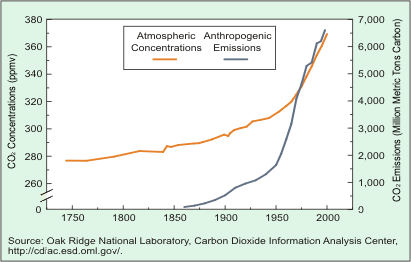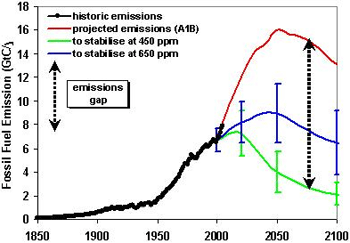Growth rate of carbon dioxide emissions doubles since 1990s
Growth rate of carbon dioxide emissions doubles since 1990s
mongabay.com
November 27, 2006
Emissions of global warming gas accelerate
The growth rate of carbon dioxide emissions has more than doubled since the close of the 1990s as countries have failed to reign in use of fossil fuels, says a new report from the Global Carbon Project, a group involved in scientific research on the impact of carbon on the planet. The finding was announced at the Annual Science Meeting at Tasmania’s Cape Grim Baseline Air Pollution Station.
Dr Mike Raupach, co-Chair of the Global Carbon Project and a research scientist at Australia’s CSIRO Marine and Atmospheric Research Group, 7.9 billion metric tons (gigatons) of carbon were emitted into the atmosphere as carbon dioxide in 2005, up from 6.8 gigatons in 2000.
“From 2000 to 2005, the growth rate of carbon dioxide emissions was more than 2.5 per cent per year, whereas in the 1990s it was less than one per cent per year,” noted Raupach. “Recent emissions seem to be near the high end of the fossil fuel use scenarios used by the Intergovernmental Panel on Climate Change (IPCC). On our current path, it will be difficult to rein-in carbon emissions enough to stabilise the atmospheric carbon dioxide concentration at 450 ppm.”
Raupach said that while China’s carbon emissions are currently growing at the fastest rate, its per capita emissions are still below the global average. To date its “accumulated contribution since the start of the industrial revolution around 1800 is only five per cent of the global total… [compared to] the US and Europe which have each contributed more than 25 per cent of accumulated global emissions.” China’s CO2 emissions are expected to surpass those of the United States — the current leader of carbon dioxide pollution — by 2009, but even by 2030, its emissions per person are projected to still be only half to three-fifths of the average in industrialized nations.

|
Dr Paul Fraser, also a scientist from CSIRO Marine and Atmospheric Research, adds that atmospheric levels of carbon dioxide climbed by two parts per million in 2005, the fourth consecutive year of above-average growth.
“To have four years in a row of above-average carbon dioxide growth is unprecedented,” said Fraser. “The trend over recent years suggests the growth rate is accelerating, signifying that fossil fuels are having an impact on greenhouse gas concentrations in a way we haven’t seen in the past.”
The Australian results, based on 30-years of measurements from the Australian Bureau of Meteorology’s observation station in Cape Grim, is in line with other figures released by the U.N.’s World Meteorological Organization (WMO) earlier this month. WMO found that carbon dioxide (CO2) levels now stand at 379.1 parts per million (ppm), up from 377.1 ppm in 2004. Currently carbon dioxide levels are 27 percent higher than at any point in the last 650,000 years, according to research published a year ago in the journal Science.
Atmospheric CO2 levels have climbed by more than 35 percent since the beginning of the industrial revolution. Fossil fuel combustion, which releases carbon dioxide into the atmosphere, and land-use change, including deforestation, is blamed for the rise. Roughly 75-80 percent of anthropogenic carbon dioxide results from fossil fuel burning, while about 20-25 percent is produced by deforestation. The United States, the world’s largest economy and consumer of energy, produces about 24% of global carbon dioxide emissions.
Raupach says that nearly half of all emissions from fossil fuel use and land-use changes (i.e. deforestation) remain in the atmosphere, with the balance absorbed by oceans and land. However he warned that shifts in carbon absorption could have a dramatic effect on atmospheric concentrations of the gas.
“A danger is that the land and oceans might take up less carbon dioxide in the future than they have in the past, which would increase the rate of climate change caused by emissions.”
Scientists believe rising levels of carbon dioxide and other greenhouse gases are causing Earth’s atmosphere to warm. Research released earlier this year by NASA, WMO, and the National Academy of Sciences found that 2005 was the warmest year in at least the 400 years, and possibly much longer. The WMO says that carbon dioxide has accounted for 90 percent of warming over the past decade.
The Intergovernmental Panel on Climate Change (IPCC) projects that atmospheric carbon dioxide levels could rise to 450-550 ppm by 2050, possibly resulting in higher temperatures, rising sea levels, stronger storms and hurricanes, and expanding deserts.

Global carbon-dioxide concentrations with anthropogenic emissions, 1750-2000.
This article used information from past mongabay.com articles as well as quotes from a CSIRO news release.
